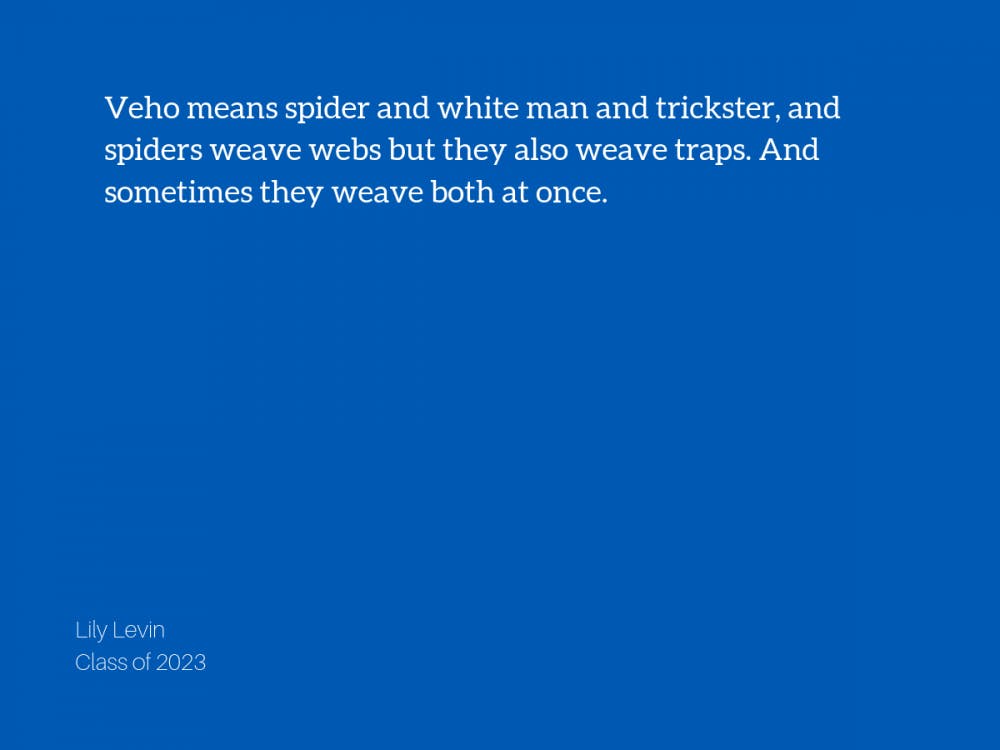Editor's note: Every year, the Duke Honor Council invites incoming first-year students to submit essays inspired by the Duke summer reading book. The following essay by Lily Levin was this year's winner.
From the moment in which we breathe our first breath to the hour in which we sloppily articulate our first words to the day in which we cease to breathe and articulate, our lives are recorded, replayed, reshuffled through the art of storytelling. We’re inundated with the ever-present humdrum of our mere existence; the only way to distinguish what is from what isn’t lies in our ability to tell the genuine, the lived—the felt. So—at Duke, in our communities, within every interaction—to effectively approach narratives, we must expose the rarely-communicated, emphasize fluidity in our encounters, and paint with nuanced shades of grey.
The rarely-told lies within the cracks of our chiseled walls, the shadows unreached by our light, the drawing-out of our vulnerability. We cannot approach the raw, painful, anti-revisionist past without acknowledging the limitations of our understanding. In There, There, Tommy Orange provides a basic background of Native American genocide, assuming that we do not know, but that we can be taught. He writes, “Thanksgivings like these happened everywhere, whenever there were what we have to call 'successful massacres'" (5). Orange matter-of-factly dismantles glamorized narratives surrounding Thanksgiving, generating a deeper understanding of America’s genocidal history. At Duke, we can follow Orange’s example by advocating for exponentially more Indigenous Studies courses (currently, our only related class is “American Indians until 1815”) and providing comprehensive anti-racism training. In short, Duke must take advantage of opportunities presented within higher education and we, as humans, must break past the confines of our peripheral vision.
Because it is fermented in our souls, in our ever-changing consciousness, fluidity is a vital aspect of approaching stories. Orange approaches fluidity through a character, Dene Oxedene, who attempts to quantify his Indigenous heritage. “Our ancestors fought to stay alive, so some parts of their blood went together with another Nation’s and made children...forget them even as they live on in us” (150)? Oxedene phrases this statement as if it is a question, one of the immutable unknown. One thing is certain: blood fluidity equals racial fluidity equals human fluidity. Orange deconstructs America’s predisposition toward race, toward anti-fluidity, all measured by pints of blood and half-gallons of skin pigmentation. We’ve allowed—no, celebrated—a legal system that once quantified Black people as three-fifths human. We grant those incarcerated who’ve committed felonies humanity in census-taking but not in vote-casting. And so we are hypocritical determined to enumerate the intangible. No body can be constructed with three out of four quarts of needed blood.
The most important aspect of approaching storytelling, however, is correctly analyzing the subtle greys in which the words are illustrated. Orange underscores this perspective: “A Cheyenne word: Veho. It means spider and trickster and white man” (169); “spiders carry miles of web in their bodies, miles of story, miles of potential home and trap” (163). Orange manipulates the word “spider”: spiders are equally story as they are trickster; equally home as they are white man. He asks if white man equals home and therefore poses a premeditated question: what does home mean?
I challenge myself to approach narratives with a similar degree of intention. I am a white Jewish cisgender woman; I must constantly evaluate myself and expand my worldview. My home is comfortable; my friends in Duplin County, North Carolina—one hour driving-distance from this home—are neighbors to the environmentally-racist hog industry. The hog waste runoff following Hurricane Florence prevented their homes from accessing potable water for four months. I fiercely advocated for them to speak at an activism summit I’d helped plan; in that setting, their voices were infinitely more important than mine. I, and we collectively, cannot merely approach new stories differently; we must live them differently. Veho means spider and white man and trickster, and spiders weave webs but they also weave traps. And sometimes they weave both at once.
Approaching storytelling to ensure a deep understanding of narratives is a difficult concept because storytelling, by its own right, is difficult. But when one glances harder at this three-part formula, perhaps everything becomes a little bit easier, because Veho means spider and spiders are made of blood and blood contextualizes history. And history is the story of humankind.
Lily Levin is a Trinity first-year. Her essay, "Spiderwebbing," won the 2019 Honor Council Essay contest.
Get The Chronicle straight to your inbox
Signup for our weekly newsletter. Cancel at any time.

